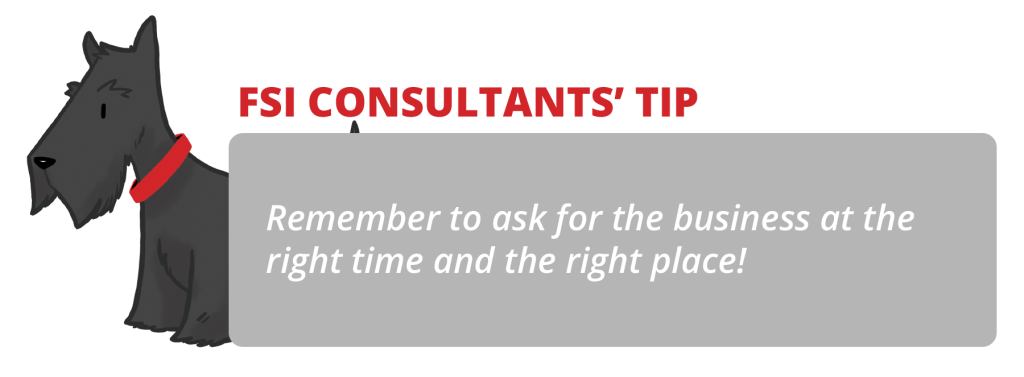Financial institutions have been around for ages. As time has gone by, traditional marketing methods of marketing and selling products have been established. One of the main goals of marketing is to draw potential customers to traditional branches. Most consumers do not make a habit of dropping by their financial institution, let alone one they have no relationship with, to browse around. Therefore, a high percentage of time, effort and expense is dedicated toward getting the opportunity to discuss and promote a product or service.
Make A Friend…Make A Customer®
A tremendous advantage In-Store Branches have is the ability to meet, greet, and speak to thousands of customers and potential customers each week. One of the foremost reasons that a retail store is an ideal location for an In-Store Branch is the frequency in which customers visit the store. These frequent visits give staff members the opportunity to build awareness, friendships, and financial relationships with these customers.
Let’s contrast this with another environment. Say, for instance, that the In-Store Branch was located at a trade show. At these settings, customers walk the aisles expecting to hear a sales pitch. Trade shows typically happen only once or twice a year, so it is critical that vendors make a strong sales pitch while they can. Many vendors are competing for very limited personal contact opportunities. However, even if the salesperson is a bit too aggressive, the damage is usually minimal. He or she will probably not see that customer again for six months to a year, if at all.
The opposite is true in the retail environment. Customers visit the store to shop. They are typically not prepared or willing to be aggressively pursued. Beyond that, there is much more risk involved with the possibility of aggravating a potential customer. As opposed to a trade show, you will probably see the retail customer again in only a few days. That person can either look forward to seeing you or have a negative image of the In-Store Branch and its staff. Positive or negative experiences can have a “snowball” effect throughout your target market.
Each individual has his or her own comfort zone and “speed of acceptance”. Some customers will immediately be willing and eager to discuss their financial needs. They are more open to change and are quicker to consider the advantage of banking within the retail store. Others will need longer periods of time to accept who you are, realize the advantage of doing business with an In-Store Branch, and eventually, take action to become a customer. Your job is to proactively market and sell the financial institution’s products and services. This, in turn, will assist in speeding up the decision to choose your In-Store Branch for their financial needs.
Do not assume “eventually” means a long time in the future. “Eventually” can be anytime from a few days to several months to a year or more. The point is that most individuals are not mentally prepared to make what is perceived to be a major decision (switching financial institutions) on the spur of the moment. It is therefore not fair to you or the potential customer to force a yes-or-no decision on the spot.
If your retailer was full of individuals without a current financial institution, your job would be far less involved. However, in the real world, these people already have relationships with financial institutions. The integrity of those relationships will vary, but they do exist. It is therefore unreasonable to think that these individuals will immediately decide to leave their current financial institution for the In-Store Branch on the spot. It is important that your marketing and selling to these individuals is steady, positive, and friendly.
The methods of selling will vary: personal conversations, PA announcements, in-store signs, etc. However, each method must consistently be positive and raise awareness. The In-Store Branch staff needs to be diligent in making positive acquaintances and building friendships. A person is far more likely to consider doing business with a personal acquaintance, or better yet, a friend. Therefore, Make a Friend, Make a Customer®.
Believe Then Sell
When a person sincerely believes that his or her product is right for a customer, selling is a natural process. Each In-Store Branch will have its own strategies in marketing and selling. Regardless of the techniques and methods used, it is important that staff members understand their purpose and believe in what they sell.
- We want our In-Store Branch to assist with the overall goals for our financial institution.
- Regardless of whether or not a person is currently a customer, you want the to think highly of the In-Store Branch and its staff.
- The In-Store Branch is the best choice for anyone that shops the retailer on a regular basis. It’s our job to help them realize this.
- You can ask store customers to become your customers with total sincerity, because we know they will not regret this. You have good products. Your staff will give the kind of service that will keep customers satisfied and the schedule is focused on giving them the most convenience possible.
- Even if a store customer is not yet interested in becoming your customer, one day he or she will. You are the best financial institution for them. Being their friend, and eventually… their personal financial representative. When they do their banking with you,they’ll be glad they did.

Portrait of a Salesperson
Consider the average salesperson. The stereotypical image that comes to mind is that of a used car salesman. The perception here is that the used car salesman is pushy, obnoxious, aggressive and bent on selling us something we don’t want or need. However, a used car salesman has a certain advantage over In-Store representatives. When a shopper is on the car lot, the salesman knows they are in the market for a vehicle. He also knows that if he allows that shopper to leave the car lot without making a purchase, the opportunity to make a sale to that specific shopper may never happen.
On the other hand, shoppers in the retail store are typically there to shop and not necessarily looking for a financial institution. Your goal is to build relationships with shoppers with the hope of eventually converting them to customers/members of your financial institution. The advantage you have over the used car salesman is frequency. You often have the opportunity to engage in face-to-face contact with shoppers in the store an average of two to three times each week. The used car salesman often has just one opportunity for face-to-face contact.
It is beneficial for you and your In-Store Branch to find as many ways to engage with shoppers of the store and to educate them concerning all of the advantages of having a financial relationship with your financial institution. You must convey that you will give them stellar service, provide the most convenient location for them, as well as become their friend and financial confidant.
